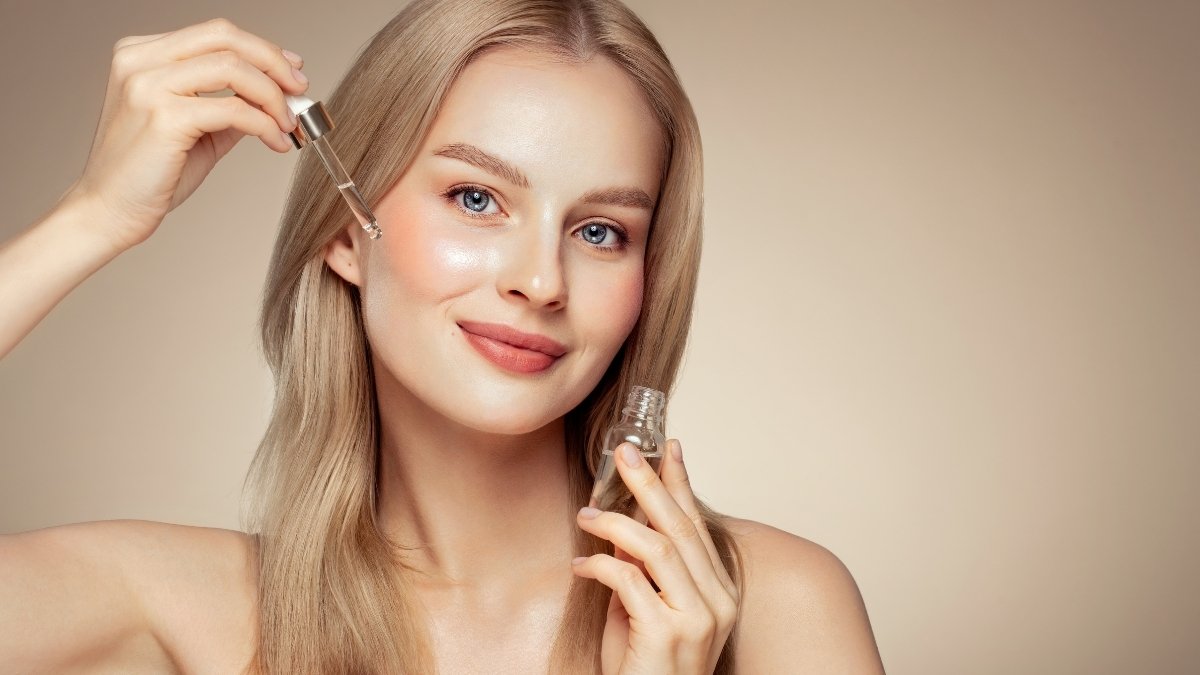The Over-50 Skin Routine That Makes Mature Skin Look Naturally Glowing

Women’s skin loses about 30% of its collagen during the first five years of menopause. But that doesn’t mean you can’t have glowing, healthy-looking skin after 50.
Many women over 50 struggle with dryness, wrinkles, loss of firmness, and dull skin tone. These changes accelerate dramatically during menopause due to hormonal shifts and declining collagen production. What worked in your 30s and 40s doesn’t work anymore.
The good news? You don’t need complicated 15-step routines or expensive products to fix this.
This guide shows you exactly what works for mature skin and why. You’ll learn the science behind your skin changes after 50, so you’re not guessing anymore. You’ll get a simplified 5-step morning and 4-step evening routine backed by dermatologists, not social media trends.

We’ll cover the exact ingredients proven to work for aging skin care, how to layer products so they actually absorb, and realistic timeframes for seeing results. No hype. No magic promises. Just an over 50 skin routine that makes your mature skin look naturally glowing.
Why Your Skin Changes Dramatically After 50
If you’ve noticed your skin looking different after 50, you’re not imagining things. Real biological changes happen during menopause that affect how your skin looks and feels.

But here’s what you need to know: only 20% of aging is inevitable. You can actually do something about the rest.
The Collagen Crisis
Your skin loses about 30% of its collagen in the first five years after menopause. That’s a huge drop in a short time.After that? You keep losing about 2% every year for the next 20 years. Think of collagen as your skin’s scaffolding. It keeps everything lifted, firm, and smooth.

When it breaks down, your skin loses structure. That’s why skin that looked plump at 48 might look deflated at 53.
What Menopause Does to Your Skin
Estrogen doesn’t just affect your mood and body temperature. It tells your skin cells to make collagen. When estrogen drops during menopause, your skin gets the message to slow down collagen production.

This also means your skin holds less moisture, feels thinner, and takes longer to heal from cuts or irritation.
Your Skin Barrier Gets Weaker
Starting at age 25, your body makes less of two key things: ceramides and hyaluronic acid. These keep moisture locked in your skin. By age 40, your skin barrier can be 60% weaker than it was at 20.

The result? Dry, tight skin that feels sensitive. Products that never bothered you before might suddenly sting or irritate.
You’re Not Stuck With This
A dermatologist from Yale puts it perfectly: “What worked in one chapter of my life won’t serve me in another, because skin adapts with age, hormones, climate, and environment.”

The good news: Your skin can still look healthy and glowing. You just need to work with these changes, not against them.
The Essential 5-Step Morning Routine for Glowing Skin
Your morning skin routine over 50 doesn’t need to be complicated. These five steps take less than 10 minutes and give your mature skin exactly what it needs to look healthy all day.
Step 1: Wash With a Gentle, Creamy Cleanser
Forget foaming cleansers. They strip away the natural oils your skin desperately needs right now.
Look for cream-based cleansers with hyaluronic acid, glycerin, and ceramides. These ingredients clean your skin while adding moisture back in. CeraVe Hydrating Facial Cleanser is a solid choice that won’t break the bank.

Here’s a simple test: If your skin feels tight or squeaky after washing, your cleanser is too harsh. Your face should feel clean but soft, not stripped.
Step 2: Apply Hyaluronic Acid to Damp Skin
This step is a game-changer for dry, mature skin. Hyaluronic acid holds up to 1,000 times its weight in water. Yes, really.
Pat it onto damp skin right after cleansing. This is important. The dampness helps it work better. The Ordinary Hyaluronic Acid serum costs under $10 and works just as well as expensive brands.

Wait about 30 seconds before the next step. You want it to sink in, not just sit on top.
Step 3: Add an Antioxidant Serum
Pick either Vitamin C or niacinamide. Both protect your skin from daily damage and make it brighter.
Niacinamide is the better choice for sensitive mature skin. Studies show that 5% niacinamide used twice daily for 12 weeks reduces fine lines, wrinkles, dark spots, and redness. It also helps your skin make more collagen and hold moisture better.

Paula’s Choice 10% Niacinamide Booster or The Ordinary Niacinamide 10% both work well. Start with a few drops and press it into your skin.
Step 4: Lock It In With a Ceramide Moisturizer
This seals in everything you just applied. Ceramides fix your skin’s moisture barrier so water can’t escape.

Look for a moisturizer with all three essential ceramides. CeraVe moisturizers have these and cost less than $20. Your skin should feel comfortable, not greasy.
Step 5: Never Skip SPF 30 or Higher
This is the most important step. Period.
80% of skin aging comes from sun damage. Sunscreen does more to prevent aging than any other product you can buy. A dermatologist puts it simply: “Sunscreen absolutely makes a difference in aging—more than any other skin care product.”

SPF 30 blocks 97% of harmful rays. SPF 50 blocks 98%. Pick one with added hydrators so it doesn’t feel heavy. Apply it every single day, even when it’s cloudy.
Mineral sunscreens with zinc oxide work great for mature skin because they don’t irritate. Tinted versions give you a slight glow too.
The Weekly Treatments That Make a Difference
Your daily routine does the heavy lifting. But adding a few weekly treatments can take your skin from good to glowing.
Exfoliate Gently (Once or Twice a Week)
Your outer skin layer gets thinner as you age. This means you need to be careful with exfoliation for mature skin.
Use glycolic or lactic acid pads instead of harsh scrubs. These chemical exfoliants dissolve dead skin cells without scratching or damaging delicate skin. The Ordinary has affordable options that work well.

Start with once a week. If your skin handles it fine, you can go up to twice a week. But watch for redness or irritation. Less is more here.
Never exfoliate on the same night you use retinol. That’s too much for mature skin to handle.
Add a Hydrating Face Mask
Face masks over 50 aren’t just for Instagram selfies. They actually work.
Sheet masks with hyaluronic acid give your skin an instant moisture boost. Use them 1-2 times per week, especially when your skin feels extra dry or looks dull.

Overnight sleeping masks are even better. You put them on as your last step before bed, and they work while you sleep. Your skin looks plumper in the morning.
Don’t Forget Your Body
Here’s what most women miss: your face isn’t the only skin that ages.
A Yale dermatologist says it perfectly: “Neglecting 90 percent of your skin is a mistake. I give TLC to my arms, chest, and legs with exfoliating body washes and daily SPF, plus body lotion with retinol.”

Your neck, chest, and hands show age just as much as your face. Apply the same products you use on your face to these areas. Yes, that includes SPF every single day.
Body lotion with retinol helps with crepey skin on arms and legs. Use it at night after your shower.
Common Mistakes to Avoid After 50
Even with good intentions, these skincare mistakes over 50 can sabotage your results. Here’s what to stop doing right now.
Using Products That Are Too Harsh
Your skin at 50 isn’t the same as it was at 30. Stop treating it like it is.
Foaming cleansers strip away the natural oils your mature skin desperately needs. Switch to cream cleansers instead. If your face feels tight or squeaky after washing, that’s a problem.

Strong acids without proper buffering can damage your thinner skin barrier. Over-exfoliating is even worse. Limit exfoliation to once or twice a week, maximum.
Skipping Sunscreen on Cloudy Days
This is a huge mature skin care error. Even on cloudy days, 40% of UV radiation still reaches your skin.
Here’s the reality: only 23% of your lifetime sun exposure happens by age 18. The rest happens as an adult. Every day without SPF adds up to more wrinkles, dark spots, and sagging.

Cloudy day? Wear SPF. Winter? Wear SPF. Just running errands? Wear SPF. Make it automatic.
Layering Products in the Wrong Order
This wastes money and reduces how well your products work.
The rule is simple: thinnest to thickest. Water-based serums go on before oil-based moisturizers. If you do it backwards, the heavier product blocks the lighter one from getting into your skin.

Give each product 30-60 seconds to absorb before adding the next one. Rushing makes everything pile up on the surface instead of sinking in.
Expecting Results Too Fast
Skincare isn’t magic. It takes time.
Here’s what’s realistic: Your skin barrier improves in 2-4 weeks. Redness reduces in 2-4 weeks. Dark spots fade in 4-8 weeks. Fine lines soften in 8-12 weeks or longer.

Most women quit after two weeks because they don’t see instant changes. Don’t be that person. Consistency beats perfection every single time.
Forgetting Your Neck, Chest, and Hands
Your face isn’t the only place that shows your age.
Your neck, chest, and hands age just as fast as your face—sometimes faster. But most women stop their skincare routine at the jawline.

Apply everything you put on your face to these areas too. Yes, including the expensive serums. These spots can give away your age faster than anything else.
Real Results: What to Expect and When
Here’s the honest skincare results timeline. No hype, just what actually happens when you stick with a routine.

Weeks 1-2: You’ll Feel the Difference
Your skin will feel more hydrated and comfortable. That tight, uncomfortable feeling after washing? Gone.

When you touch your face, the texture feels smoother. These changes happen fast because you’re finally giving your skin the moisture it needs.
Weeks 4-6: Others Start to Notice
Your skin tone looks more even. Redness and irritation calm down.
This is when the glow starts coming back. Your skin looks healthier, like you’ve been sleeping better or just got back from vacation.
Weeks 8-12: The Big Changes Show Up
Fine lines start to soften. Your skin looks firmer and brighter.

Dark spots begin to fade, though they won’t disappear completely yet. This is when people might ask if you’ve done something different. The answer is yes—you stuck with it.
3-6 Months: Your Skin Transforms
The texture of your skin improves significantly. Even deeper wrinkles look softer.
Your overall skin quality is different now. It’s not about looking 20 again. It’s about looking like the healthiest version of yourself right now.
A dermatologist says it best: “Learn what makes your skin unique, embrace its beauty, and customize your routine to what works for you, not your friend or what’s trending on TikTok.”

Your results depend on consistency and your starting point. Some changes happen gradually. You might not notice day-to-day, but compare photos from three months ago. That’s where you’ll see it.
Final Thoughts:
The changes your skin goes through after 50 are real and dramatic. But they’re also manageable when you know what to do.
A simple 5-step morning routine and 4-step evening routine is all you need. Focus on the proven ingredients: retinol, niacinamide, hyaluronic acid, ceramides, and SPF. These aren’t trendy—they’re backed by science.
Consistency beats perfection every time. You don’t need to do everything perfectly. You just need to show up for your skin every day.

Results take 8-12 weeks, but they’re worth the wait. Your skin didn’t change overnight, and it won’t transform overnight either.
Start with the basics if you’re feeling overwhelmed. Get a gentle cleanser, a good moisturizer, and SPF 30 or higher. Master those three. Then add active ingredients one at a time.
This over 50 skin routine for naturally glowing mature skin doesn’t require expensive products or complicated steps—just the right ingredients used consistently.
Your skin at 50+ can absolutely glow. You just need patience, the right products, and realistic expectations.






